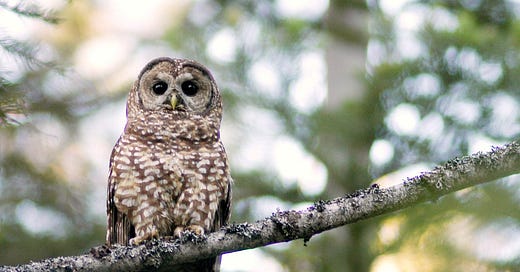The story of the northern spotted owl, its dwindling numbers and the fierce battle over its existence and its habitat, is one of greed, ideologies, politics, and lies—and one that I’ve witnessed for decades.
The northern spotted owl (Strix occidentalis caurina) is the largest of the three subspecies of the spotted owl (Strix occidentalis). It is found in thickly wooded canyons and humid forests in parts of the West and Northwest. The birds are about 1.5 feet tall, with a wingspan up to four feet. Females are larger than males.1
Their preferred habitat is old-growth forests. The owls like this habitat because these forests have high canopies, lots of standing dead trees, and plenty of open spaces between trees to fly through. People like old-growth forests because they can make a lot of money when they chop them down, particularly when the forest is clearcut.
Clearcutting, as you probably imagine, is cutting down all or almost all of the trees in a region of a forest. Clearcutting might be thought of as the fast food of forestry. It’s fast, cheap, and can make corporations lots of money quickly.2 But, like anything else that is fast and cheap, there are consequences. The ecosystems of clearcut forests suffer. The soil surface goes from shaded and cool to being brightly sunlit, drier, and warmer. Tree roots die away, and falling rain is no longer buffered by leaves and branches, making it easier for storms to wash away soil, fungi, and organic matter. The increased erosion diminishes the water quality of nearby streams.3
Reagan becomes president and there’s big money to be made
As president in the 1980s, Ronald Reagan soon turned the focus of the U.S. Forest Service from one of stewardship to one of being a servant of big business interests. In 1981, the chief of the Northwest Pine Association, an industry front group, said that saving 112 pairs of northern spotted owls would deprive the timber industry of $32 million ($56 million today) and cost 600 jobs. The Reagan administration echoed the sentiment of the timber industry. “How many owls can we afford to protect?” was the question posed by John Crowell Jr., Reagan’s appointee as Assistant Secretary of Agriculture for natural resources and environment.4
Much unchecked clearcutting ensued. By 1986, the U.S. Forest Service estimated that the population of northern spotted owls had been cut in half because of logging in Oregon and Washington.5
Subsequent administrations have gone back and forth on the owl, the track record of Democrats being generally better than that of the GOP. The craziness of the Reagan administration abated during the first Bush administration, with cutbacks to logging.6 During this time, however, the timber industry made one of its most cynical moves. Logging companies began shipping almost all of their timber overseas, leaving American mills idled and mill workers unemployed. Mills and their workers put pressure on the federal government to allow more harvesting in national forests because by law, timber harvested from national forests, where virtually all old growth remained, could not be exported. At the time, the old growth was being logged at nearly 1,200 acres a week.7
President Clinton took a more aggressive approach to protect the owl. He appointed Jack Thomas, who had advocated for logging cutbacks to save the northern spotted owl from extinction, as head of the U.S. Forest Service.8 The Clinton administration also developed the Northwest Forest Plan, which led to science-based decisions on logging and something of a recovery plan for the owl. The plan also benefitted hundreds of other species whose habitat is old-growth forest.
The fate of the northern spotted owl then became more of a political football. Forced by a lawsuit to draw up a recovery plan for the northern spotted owl, George W. Bush stacked the group in charge of drafting the plan with industry and government representatives and severely weakened forest protections. The incoming Obama administration scuttled Bush’s plan. The Trump administration removed 3.5 million acres from the owl’s designated critical habitat, a move the Biden administration reversed.
Current status of the northern spotted owl
A scientific study performed in 2015 found that the northern spotted owl was dwindling throughout its range, and the rate of decline was increasing. The study found that in the 30 years since monitoring of the owls began, populations had declined by 55 to 77 percent in Washington state, 31 to 68 percent in Oregon, and 32 to 55 percent in California.
Now the northern spotted owl faces challenges from climate change, which makes wildfire more likely within their habitat, as well as competition from another owl. Invasive barred owls are migrating into northern spotted owl territory and outcompeting the native owls for food. Conservationists have taken the controversial step of shooting the invading owls.
I am not yet ready to give up hope for the northern spotted owl. Nonetheless, I worry that the presidency could go back to the GOP. Once a forest is clearcut, it might take 200 or 300 years for it to regain the old-growth characteristics that the owl needs, and the northern spotted owl can’t wait that long.
For more environmental science & news follow me on Twitter @EcoScripsit.
National Geographic Field Guide to the Birds of North America. Fifth Edition National Geographic, Washington D.C. 2006 pp. 258
Lerner, K.L. (2021) 'Clear-Cutting' in Nemeh, K.H. and Longe, J.L., eds., The Gale Encyclopedia of Science, 6th ed., vol. 2, Farmington Hills, MI: Gale, 981-982, available: https://link.gale.com/apps/doc/CX8124400558/GRNR?u=sddp_main&sid=bookmark-GRNR&xid=0f089b78 [accessed 28 Sep 2022].
Ibid
AP 1981, Loggers Confront Spotted Owls On Pacific Northwest Lands, Late Edition (East Coast) edn, New York, N.Y.
Special to the New,York Times 1986, Forest Service Backs a Plan To Protect Owls in Northwest, Late Edition (East Coast) edn, New York, N.Y.
AP 1990, Government Plans Major Cut In Washington State Logging, Late Edition (East Coast) edn, New York, N.Y.
Timothy Egan, Special to the New,York Times 1989, Judge Allows Timber Cutting in Owl Habitat, Late Edition (East Coast) edn, New York, N.Y.
Spotted Owl Defender Is Chosen To Be Chief of the Forest Service: [Biography] 1993, Late Edition (East Coast) edn, New York, N.Y.








Great article and call to action. Thanks!
Thanks for this important update on the Spotted Owl! I was involved in forest defense in Oregon in the early 2000s. At action camps in the forest we would hear the Spotted Owls. We would mimic their calls and they would call back and come closer. I never saw one, but heard many. It was a very magical experience.
Just a couple notes about the Clinton administration:
The Northwest Forest Plan of 1994 restarted logging of old growth, which had been halted for three years due to successful lawsuits. The goal of "zero cut" had in fact been attained by hard work from environmentalists, but with the plan, Clinton retreated from that. The conference Clinton set up that hammered out the plan was dominated by logging interests so this is not surprising. It was seen as a terrible blow at the time by many forest defenders.
You didn't mention (so I am assuming you haven't heard of) the infamous "Salvage Rider" that Congress passed and Clinton signed the very next year, 1995, which was terrible for old growth throughout the West, including Spotted Owl habitat. Forest defenders at the time called it the “Logging without Laws” rider. Quote: "The Salvage Rider directed the Forest Service to cut old-growth timber in the Pacific Northwest that the agency had proposed for sale but subsequently withdrew due to environmental concerns, endangered species listings, and court rulings." This, in effect, crippled much of the NW Forest Plan. Though the rider was temporary, just three years long, the damage done during that time was horrific.
Fun fact: "Mark Rey, a former lobbyist for the timber industry and former head of the United States Forest Service under Bush, authored Bush’s forest plan [the so-called "Healthy Forests Initiative"] and Clinton’s salvage bill while working as an aide for Republican Senator Larry Craig of Idaho."
Some details are in this article by Joshua Frank (from which I pulled the above quotes):
https://www.counterpunch.org/2017/08/04/the-inconvenient-truth-about-al-gore/
If you'd like to know more about the betrayals of our forests by the Clinton administration, here's an interview I did with Tim Hermach, founder and director of the Native Forest Council (in Eugene, Oregon), whose forest defender days go back to the 1980s. He claims (and would know) that more old growth was cut during the 8 years of Clinton than under the 12 of Reagan/Bush I.
https://radiofreesunroot.com/2021/01/19/ep-51-spark-of-fury-feat-tim-hermach/